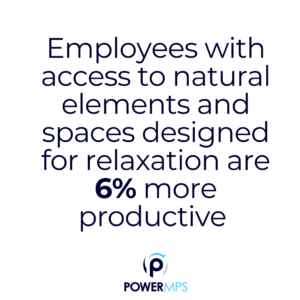Creating a positive and healthy work environment is essential for employee well-being and productivity. In recent years, especially since the pandemic, businesses have recognized the importance of incorporating wellness spaces into the workplace. These dedicated areas provide employees with opportunities to relax, recharge, and prioritize their physical and mental health.
In today’s brisk work environment, employees’ mental health should be the top priority of organizations. After all, a happy employee is a productive employee. As businesses strive to create a positive and productive work culture, incorporating wellness spaces into the office has become a prevalent trend.
The Rise of Wellness Spaces
In the late 1980s, companies focused on psychological well-being as part of their workplace wellness initiatives. In pop culture, these efforts were fueled by the popularity of an exercise video series released by Jane Fonda at the start of the decade.
Workforce wellness grew in popularity at that time due to diminished employee loyalty, resulting from tumultuous economic issues and distrust in corporations. Employees started protecting their own needs in comparison to the wants of their employer. In 1986, OSH began to encourage implementing stress-related mental health programs in the workplace.
By the new millennium, workplace wellness programs were fairly established domestically. A 2008 Employer Health Benefits Survey reported 70% of large companies in America had workplace wellness programs. It also helps that global businesses are experiencing drastic innovation due to technological advances.
The Current Landscape
As we continue the second decade of the 21st century, the workplace wellness journey has gone full steam ahead, increasing awareness and prevention services. Today’s workplace wellness programs are designed primarily as preventative care for innumerable health conditions.
Screenings and health risk assessments accurately detect acute and chronic conditions. Mental and emotional health services have been emphasized with increased absenteeism due to the global pandemic. Teams of clinical and non-clinical practitioners include mental, behavioral, and integrative health working in partnership with health, wellness, and professional recovery coaches. Because of the isolation of 2020, the need for mental and behavioral health services has never been more prevalent. So has an increased want of wellness spaces in the workplace.
The Impact of Wellness Spaces on Employee Health
 Research shows that incorporating wellness spaces into the office can significantly impact employee health. According to a study by the World Green Building Council, employees with access to natural elements and spaces designed for relaxation and rejuvenation experience a 15% increase in well-being and are 6% more productive. Furthermore, according to Gallup, engaged employees are 21% more productive than their disengaged counterparts.
Research shows that incorporating wellness spaces into the office can significantly impact employee health. According to a study by the World Green Building Council, employees with access to natural elements and spaces designed for relaxation and rejuvenation experience a 15% increase in well-being and are 6% more productive. Furthermore, according to Gallup, engaged employees are 21% more productive than their disengaged counterparts.
Understanding the connection between employee happiness and overall organizational health is vital. By providing areas for physical activity, quiet reflection, or even a quick power nap, employers can help reduce stress, boost mental clarity, and improve overall employee health.
Designing Relaxation Zones
Creating dedicated relaxation zones within the office environment can offer employees a retreat from the demands of their workday. These spaces can be designed with comfortable seating, soothing lighting, and calming elements such as plants or water features.
For example, Google has incorporated nap pods in their offices, providing employees with a quiet space to recharge. Additionally, Salesforce has installed meditation rooms in their offices, recognizing the importance of mental well-being in achieving optimal performance. Employees can take short breaks to relax and return to their tasks feeling refreshed and rejuvenated by designating specific areas for relaxation.
Incorporate natural elements like plants and natural light to create a calming environment. Provide ergonomic furniture and adjustable workstations to promote good posture and reduce the risk of musculoskeletal issues.
Prioritizing Physical Activity
Encouraging physical activity at work is vital for maintaining employee well-being. Many forward-thinking companies have implemented on-site fitness facilities or designated exercise areas within their office spaces. These spaces are equipped with exercise equipment, such as dumbbells, treadmills, or yoga mats.
For instance, Zappos and USAA offer an on-site gym and organize employee group exercise classes. Regular physical activity improves physical health, increases energy levels, reduces stress, and enhances cognitive function. Fitbit reports that employees who engage in physical activity during the workday have 53.8% lower healthcare costs.
Embracing Nature & Biophilic Design
Biophilic design, which incorporates elements of nature into the workplace, has gained popularity for its positive impact on employee well-being. Natural light, indoor plants, and views of green spaces have been shown to reduce stress, enhance mood, and improve productivity. Amazon’s Spheres, a collection of glass domes filled with plants, exemplifies this approach. By integrating nature-inspired elements, employers can connect with the outdoors and promote a sense of calm and serenity in the workplace.
Supporting Mental Health
As mentioned earlier, promoting mental health is the most important aspect of improving employee well-being. Organizations can foster a positive work environment by destigmatizing mental health and offering support. Companies must foster a supportive culture outside of wellness spaces that encourage employees to utilize these amenities. Managers should all lead by example, emphasizing the importance of work-life balance and wellness practices. Offering flexible work arrangements, promoting regular breaks, and providing access to mental health resources can further this initiative.







